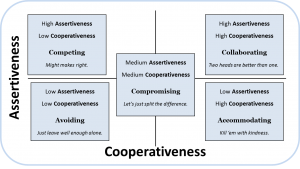Negotiate Smoothly by Understanding Conflict Styles
In sales, ever meet someone who seems to have a natural finesse for smoothing out the rough edges in a sales negotiation and an ability to defuse tension in any conflict situation?
I’ve come across a few sellers who can do this and, by watching them, I’ve learned that moving deftly through a negotiation is more about style than skill. The good news for the rest of this is that style can be learned.
 One of the definitions for “negotiate” is “to move through, around or over in a satisfactory manner.” As sellers we may forget this key meaning when we focus exclusively on the bargaining aspect of negotiation. Looking at the activity within a negotiation instead of the desired outcome from the negotiation traps many a seller. It takes style to move smoothly through a negotiation.
One of the definitions for “negotiate” is “to move through, around or over in a satisfactory manner.” As sellers we may forget this key meaning when we focus exclusively on the bargaining aspect of negotiation. Looking at the activity within a negotiation instead of the desired outcome from the negotiation traps many a seller. It takes style to move smoothly through a negotiation.
Smoothing out the rough edges and adding finesse starts with looking at the negotiation from your customer’s perspective. When you understand your own negotiating style, as well as the style of your buyer, you will have a clear advantage in negotiating. You’ll also be more effective in getting to the results that are mutually beneficial for you and for your buyer.
The Thomas-Kilmann Conflict Mode Instrument (TKI) is a well-known and widely used tool for helping people understand their own preferred style of dealing with conflict. It’s also a powerful tool for building your own insights about how others approach conflict. Understanding and learning to flex your style will improve your negotiating prowess because underlying feelings of conflict are the backdrop for many negotiations.
This blog post will be the first of four to explain conflict styles and serves as an overview of the five styles. Subsequent blogs will go into greater depth about when and how to effectively employ each of the five styles to achieve your goals in a negotiation.
The two axes in this conflict model define the level of cooperativeness and the level of assertiveness you bring into the negotiation. Being highly assertive means you are taking strong positions to be sure your needs are met. The styles called Competing and Collaborating represent highly assertive approaches to conflict. The second axes is cooperativeness which refers to the level of emphasis you are placing on your buyer’s needs. Highly cooperative styles, as illustrated here, are the Accommodating and Collaborating styles.
By contrast, you can see that low assertiveness comes when Avoiding or Accommodating. Low cooperativeness comes with Competing and Avoiding. In the middle, Compromising is the style with a moderate degree of both cooperativeness and assertiveness.
Each of these five styles has pros and cons. Each of these five styles is appropriate to use in certain negotiating situations. None of these styles is universally “better” or “worse” than the others.
What determines when and how to use any given style should be this: you should gauge the situation and the style being exhibited by your buyer.
Read that sentence again. It’s wholly different from the way most people approach a negotiation. You should gauge the situation and the style being exhibited by your buyer BEFORE you decide which of the five styles you will use in the negotiation.
You know, of course, what most sellers do instead. They have a natural preference in one or two of these conflict styles. So that is what they exhibit in all negotiations.
To identify your own natural conflict style, you can work through the formal TKI assessment. Or you can candidly assess how you responded when emotions were high in a tense, conflict-ridden situation in your personal life (where we less frequently hold back). Did you disengage and avoid further interaction? Did you come on strong and take a “win at all costs” approach? Did you yield in order to keep the peace?
Just because it is your natural style and you are comfortable in it doesn’t make it the best choice for every conflict or negotiation. Becoming aware of your automatic response and working to develop responses using the other styles is important if you hope to smooth out negotiations.
In next week’s post, we’ll take a closer look at Competing and Avoiding and when these two styles are absolutely essential. Week three will cover the Accommodating and Compromising styles and why you need to be cautious if your buyer adopts these styles. In our final post in this series, we’ll explore what it means to Collaborate in a negotiation.
As you work through this series, be mindful of the style(s) you typically use in conflict or negotiating and begin observing others’ styles, too. Soon you’ll be that seller others envy for your finesse in tough conversations.
This blog post is the first of four in a series on conflict styles and how to use them in negotiating.
To learn more about the TKI Assessment and how it can help you with negotiation and conflict resolution skills, please contact PFPS for coaching and training. You can also access the assessment directly at CPP.


